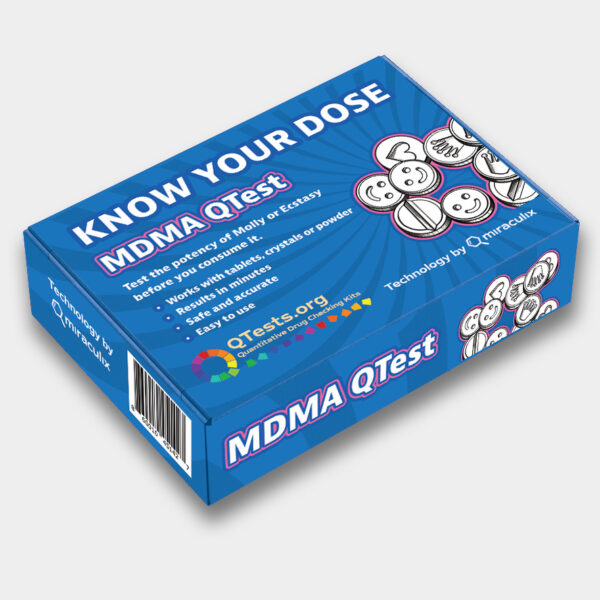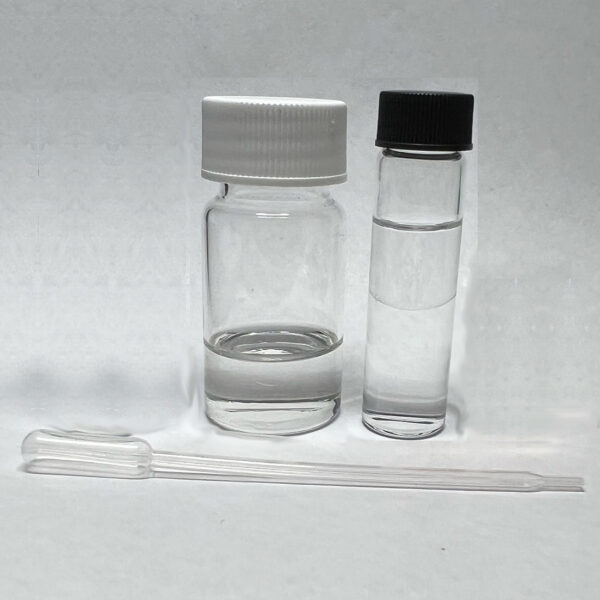MDMA QTest
$24.95
Know Your Dose! The percent purity of powder MDMA can vary tremendously. So can the amount of MDMA in a pressed ecstasy tablet. With this MDMA test kit, you can quickly and easily determine the percent purity of your molly, or how many milligrams of MDMA are in your tablet.
Note: This kit will only tell you the amount of MDMA in your sample. It will not tell you what other substances it might be cut with.
- Results in 12 minutes.
- Works with powders, crystals and pressed pills.
- Easy evaluation with the enclosed color chart.
- The only quantitative MDMA test kit on the market.
Automatic Bulk Discounts
Get 20% off when you buy five or more QTests.
- Description
- Additional information
- Instructions
Description
Know your dose with the MDMA QTest
The MDMA QTest is the first and only quantitative MDMA test kit on the market for ecstasy and molly.
This single-use kit can tell you the percent purity of MDMA powder or crystals, or how many milligrams of MDMA are in a pressed ecstasy tablet.
Use only a small amount, then compare the color of the detection vial with the enclosed color chart.

It’s that simple.
Additional information
| Weight | 3.1 oz |
|---|
Instructions
Instructions
Note: A paper version of these instructions comes with your order.
IMPORTANT INFORMATION! – READ THIS FIRST
• Make sure you have real MDMA before using this kit. If you have MDA, 6-APB or 5-MAPB instead, the kit will produce a similar reaction, but it won’t be accurate. Many companies sell multi-use MDMA test kits that give qualitative results (just not quantitative). Use one of those kits first, or buy the Advanced MDMA QTest at QTests.org.
• Use this kit at room temperature. (If stored in a refrigerator, let it warm up for one hour first.)
• Perform the test on a flat surface during the daytime.
• Evaluate the result in daylight immediately after the 12-minute development time. (The color can change if you wait too long.)
• Use a white, letter-sized sheet of paper as a background when evaluating the color. (See section four for evaluation details.)
• This kit should only be used on pills, powders and crystals. It does not work on liquids.
• Read all the instructions at least once through before beginning the test.
1. BACKGROUND INFORMATION
This quantitative test kit can be used to detect the concentration of MDMA in powders, crystals and pills (including pressed tablets of any color) that have first been verified to contain MDMA. (Use a qualitative MDMA test kit first to make sure you have MDMA, or buy the Advanced MDMA QTest at QTests.org.
2. PREPARING FOR THE TEST
Take out all the items from your kit. Along with these instructions, you should have:
• protective gloves
• thin glass vial with black lid (extraction vial)
• large glass vial with white lid (detection vial)
• plastic dropper bottle with green lid
• pipette
• evaluation color chart
You will also need a milligram scale and either a small funnel or a creased piece of paper to carefully pour the measured powder or crystals into the extraction vial. (You can make your own paper funnel. Google it!)
3. PERFORMING THE TEST
3.1 First put on the enclosed nitrile gloves and wear appropriate protective clothing and safety glasses. If you wear contact lenses, remove them. The liquids in the vials contain acids which may cause skin irritation or severe eye damage. In the event you come in contact with the liquid, remove the affected clothing immediately and rinse the affected skin area with water for several minutes. In case of eye contact, rinse the affected eye with running water for several minutes. Perform the test either outdoors or in a well-ventilated area and avoid inhaling the fumes, which can cause dizziness. (Keep pets, especially cats, away from the testing area.)

3.2 Using a milligram scale, carefully weigh out 30 mg of powder or crushed crystals. If you are testing a pressed ecstasy tablet, use 50 mg. You can either scrape off 50 mg from the edge of the tablet using a sharp knife, or even better, crush and mix the entire tablet and then weigh out 50 mg of the resulting powder.

IMPORTANT! – If you are testing a pressed ecstasy tablet, weigh the entire tablet first and write down the result. You will need to know the total weight of the tablet in order to calculate how much MDMA it contains after testing 50 mg.

3.3 Open the thin extraction vial (with the black lid) and use a funnel or creased piece of paper to carefully pour in the 30 mg of powder or crystals (or 50 mg if testing a pressed tablet). Put the lid back on the vial and close it tightly. Shake the vial for approximately one minute (or until all the soluble components have dissolved), then put it down and wait a few minutes for the insoluble components to settle to the bottom.

3.4 Open the large detection vial (with the white lid) and set the lid down next to it. Now open the extraction vial again (with the black lid) and look at it carefully. You will notice two distinct sections of liquid, one floating above the other. Using the pipette, you are going to collect liquid from the lower section. First, squeeze the top of the pipette to create a vacuum, then insert it into the vial until the bottom tip of the pipette is in the middle of the lower section of liquid. Now release pressure on the pipette and liquid will be drawn up into it. Be careful not to pick up any deposits or crumbs from the very bottom of the vial. Remove the pipette from the vial.

3.5 Drop two drops from the pipette back into the extraction vial to clear any debris that might have collected in the tip. Then, holding the pipette vertically (straight up and down), add three drops of liquid into the large detection vial. There should be plenty of liquid in the pipette to complete this step, but if it looks like you are going to run out of liquid, get some more by repeating step 3.4 above. Return any leftover liquid inside the pipette back into the extraction vial and put the pipette somewhere safe and out of the way. Then tightly close the lids on both vials.

Now pick up and shake the large detection vial several times to mix the ingredients. The color change will begin happening soon and will take 12 minutes to complete. Set a timer. After waiting 12 minutes, you can evaluate the result. See the next section, “EVALUATING THE RESULT,” for details.
4 EVALUATING THE RESULT
Follow the instructions above and wait 12 minutes before evaluating the result. Evaluate the result immediately after 12 minutes.
Comparing the intensity of the purple color with the enclosed color chart. Follow the instructions below.
• Use a white, letter-sized sheet of paper as a background.
• In daylight or under bright light, hold the glass vial next to the color chart about six to eight inches in front of the white sheet of paper and look through the glass vial head on. For best results, your eyes should be fairly close to the vial, but no closer than about six to eight inches.
• Now compare the color of the liquid in the vial to the color chart. The color bars on the chart correspond to the amount of MDMA that was in the sample you tested.
• If you tested 30 mg of powder or crystal and the color matches the 16 mg color bar, you know that your sample is approximately 50% pure (i.e., it contains 16 mg of MDMA for every 30 mg of powder/crystal.)
• If you tested 50 mg from an ecstasy tablet, divide the total weight of the tablet by 50 and then multiply by the result. This will tell you how many milligrams of MDMA were in the original tablet. For example, if your tablet weighed 460 mg, and the result shows 16 mg of MDMA in the 50 mg portion that you tested, you know there was approximately 147.2 mg of MDMA in the original tablet (460 ÷ 50 = 9.2 and 9.2 x 16 = 147.2).

IMPORTANT! – If the liquid in the vial does not turn purple, or if it turns a color other than purple, then your sample does not contain MDMA. This likely means you forgot to test your sample with a qualitative test kit first. Even if it turns purple, if you didn’t test it first with a qualitative test kit, you don’t know if it contains MDMA. (It might contain MDA, 6-APB or 5-MAPB instead.) Always use a qualitative test kit first, or buy the Advanced MDMA QTest at QTests.org.
5. STORAGE AND SHELF LIFE
It is always best to store any reagents in the refrigerator (35° – 46° F) and out of direct sunlight for the longest shelf life, but the ones in this MDMA kit can be stored at room temperature and should last at least 18 months.
6. WARNINGS
• Keep the kit away from children and animals.
• When performing the test, wear suitable protective gloves, clothing and face/eye protection. If you wear contact lenses, remove them before using the test kit.
• Perform the test outdoors or in a well-ventilated area and avoid inhaling the fumes, which can cause dizziness.
• The liquids contained in the test kit consist of various acids which may cause a corrosive/irritating effect on the skin or severe eye damage/irritation. Avoid contact with the skin, eyes, mouth or clothing.
• Should contact with the above listed areas occur, remove the relevant clothing immediately. Instantly rinse the affected skin areas with water for several minutes. In case of contact with the eyes, immediately rinse them with water for several minutes using both hands to keep the upper and lower eyelids open.
• Substances processed with the test kit are not to be consumed!
7. DISCLAIMERS
• QTests are only to be used for the detection and quantification of unknown substances.
• The result may not be 100% accurate. Your sample could be adulterated with one or more unknown substances that cross-react with the reagents, affecting the quantitative result.
• The result does not mean your sample is safe to consume. It could still contain unwanted substances and impurities that can be harmful or even deadly.
• The MDMA QTest is not a substitute for laboratory analysis.
• miraculix and/or Qtests.org assume no responsibility for the use or misuse of the test kit or the results.
8. DISPOSAL OF MATERIALS
Check your local regulations for proper disposal of acids.




